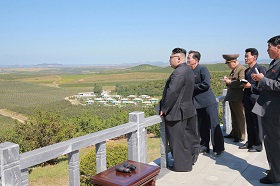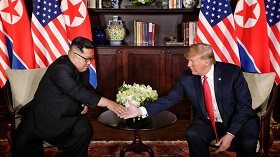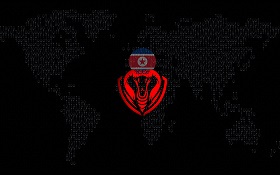Seventy years ago, the Korean nation was divided into two separate states. On August 15, 1948, the Republic of Korea was founded in the south of the Korean Peninsula, and on September 9, 1948 the Democratic People’s Republic of Korea was founded in the north.
A Longstanding Confrontation
The Korean War of 1950–1953, which saw the United States fighting on the side of the South under the UN flag, was the bloodiest and most destructive conflict since World War II. De jure, the two Korean states are still at war. This is because the Korean Armistice Agreement signed on July 27, 1953 to stop the war is nothing but an agreement between the commanders-in-chief of the two armies to suspend military hostilities. Two powerful military contingents with cutting-edge weapons and equipment are still at the ready on both sides of the 38th parallel that divides North and South Korea. And these contingents are not just made up of Korean troops. Under the Mutual Defense Treaty Between the United States and the Republic of Korea, U.S. contingent of 28,500 troops is deployed in South Korea. When Pyongyang started to develop nuclear weapons and missiles to prevent the United States from intervening in the inter-Korean military conflict, this further exacerbated the situation.
“The Asian Tiger” and a “Rogue State”
Today, South Korea is referred to as the “Asian Tiger.” It is a highly developed and prosperous state: it is the world’s second-largest shipbuilder; the third-largest manufacturer of semi-conductors and displays; the fifth-largest automobile manufacturer; and the six-largest producer of steel. South Korea invests 4 per cent of its GDP into research, more than any other OECD member, and it has the fourth-largest number of patent applications for inventions, behind the United States, Japan and China. Seoul has its own space programme and has plans to send its first probe to the Moon’s orbit by 2020 and another to its surface by 2025.
North Korea certainly lags behind South Korea in its economic development; however, statements about the country’s cultural and technological backwardness are largely the work of western media. And we are not only talking about the fact that Pyongyang would not have been able to develop its own nuclear programme that the world is so concerned about if it did not have a high level of scientific and industrial development. No one can deny that the new blocks of high-rise buildings in Pyongyang are practically indistinguishable from those in Seoul, that Pyongyang’s metro is a year older than Seoul’s, and that North Korea launched its artificial satellite before South Korea did.
Since North Korea has its own nuclear programme, the United States has declared it a “rogue state” and has not only imposed its own sanctions on the country, but has also managed to have very harsh sanctions imposed on it by the UN Security Council. It is curious, however, that the timing of the sanctions against North Korea (after the country carried out its first nuclear test) coincided with the North Korean economy emerging from the very severe economic crisis of 1995–2000, after it had overcome famine and started to show signs of economic growth. Even more paradoxically, economic growth in North Korea picked up pace significantly in 2012–2013, when the sanctions were tightened. This was primarily due to the fact that when Kim Jong-un came to power, he launched active, albeit quiet, market reforms in the country.
From Confrontation to Dialogue
The tension around Korea has been one of the greatest threats to international security in recent years. Today, the global community is focused on forcing Pyongyang to abolish its nuclear programme. However, this alone will not eliminate the threat of a new Korean war involving the United States, South Korea’s military ally. Shutting down North Korea’s nuclear programme requires, first, a reconciliation between the two Koreas and, second, solid guarantees to Pyongyang that the United States will not take aggressive measures.
2018 was marked by important positive events in Korean affairs. On April 27, President of South Korea Moon Jae-in met with the leader of North Korea Kim Jong-un in Panmunjom. Naturally, this summit between the heads of two Koreas (only the third ever) did not resolve all the problems that had accumulated in the bilateral relations over the decades of confrontation. However, it did open the way to move on to specific talks on trade and economic cooperation and a military and political détente.
We also saw the first ever U.S.–North Korea dialogue on the North Korean nuclear programme, with a summit between Donald Trump and Kim Jong-un being held in Singapore on June 12, 2018. Even though the summit’s declaration contains nothing more than generic phrases, one thing is without doubt: no nuclear or conventional war will take place in Korea in the near future. The handshake between Donald Trump and Kim Jong-un is a real contribution to the cause of peace in Korea and throughout the world.
A Complex Knot of Problems
The North Korean leadership is clearly interested in a détente on the Korean Peninsula. While the Byungjin line proclaimed by Kim Jong-un several years ago entailed building a powerful nuclear potential and creating a prosperous economy, in April 2018 the Plenum of the Central Committee of the Workers’ Party of Korea said that success in building the nuclear potential allowed North Korea to focus all efforts on building a socialist economy.
The proof of Pyongyang’s words is contained in its actions. Not a single nuclear test has been carried out for almost a year now, and missile tests have not been held for over six months. North Korea’s Punggye-ri Nuclear Test Site has been shut down.
Pyongyang appears to have a precise step-by-step programme of possible bargaining with both Seoul and Washington on mutual security commitments. Kim Jong-un, however, is clearly dragging his feet in developing the positive work started at the summits with Moon and Trump. The reason appears to be that he is not confident that both his opponents will stick to the deals. Back in the day, the conservative President of South Korea Lee Myung-bak had no qualms about abolishing his predecessor’s “sunshine policy” in the country’s relations with North Korea, while George W. Bush did not hesitate to get rid of Bill Clinton’s “North Korea Appeasement Policy.” Is there any guarantee that in a couple of years, peace-loving Moon will not be replaced with some North Korea hater, or that Trump, Kim’s counterpart in Singapore, will not be impeached?
The nuclear disarmament of North Korea and the provision of security guarantees to Pyongyang is too complicated a knot of problems to be cut in a single stoke, and by the sole hands of the United States. The solution requires multilateral international efforts, and this cannot be done without the involvement of China and Russia, two countries that have historical and geographical ties with Korea. It would appear that both the Koreas are counting on the participation of Russia and China. This much is clear from the fact that Kim Jong-un has visited China twice over the past two months, and President of the Presidium of the Supreme People’s Assembly of North Korea Kim Yong-nam and President of South Korea Moon Jae-in have both paid official visits to Moscow.
The optimal way would be to go back to the six-party talks on the Korean nuclear programme: the two Koreas, the United States, China, Russia and Japan. The talks should be structured as step-by-step negotiations using the principle of “action in exchange for action.” It would be wise at the initial stage to propose that North Korea’s nuclear programme be separated from its missile programme. North Korea’s nuclear status is set forth in the country’s Constitution, and this subject currently appears non-negotiable for Pyongyang. At the same time, a freeze on the missile programme and guarantees of non-proliferation of missile and nuclear technologies can be negotiated. Given that Pyongyang has essentially introduced a moratorium on missile launches and nuclear tests, the issue of lifting some sanctions from North Korea may be raised at the UN Security Council to stimulate Pyongyang to further roll back on its nuclear and missile programme. For instance, to get North Korea to stop developing ICBMs, freeze the production of nuclear materials and open its nuclear facilities for international inspections.
Political Steps
Several purely political steps would also be useful. For instance, it would be good to correct the entirely unnatural situation in which the United Nations, as a party to the Korean War (in that war, Pyongyang’s enemy fought under the UN flag), is still officially at war with North Korea, one of its members. For that purpose, the upcoming session of the UN General Assembly could adopt a UN Security Council declaration stating that the Korean War is in the past and that the UN Security Council is putting an end to that chapter and, therefore, the UN Command is no longer needed in Korea.
To further promote the inter-Korean détente, it would probably be useful for North Korea and South Korea to conclude an agreement between commanders-in-chief of the two countries on preventing dangerous military activities; such an agreement could serve as a landmark on the road to concluding a Peace Treaty to replace the 1953 Armistice Agreement. This would mean that any incidents that may arise due to dangerous military activities would be promptly stopped and settled through peaceful means without resorting to the threat or use of force. The document could be based on provisions of the 2015 Agreement between the Government of the Russian Federation and the Government of the Democratic People’s Republic of Korea.
Korean Affairs and Russia
The best way to diffuse tensions between neighbouring states and establish relations based on mutual trust is to run joint, long-term and mutually profitable economic or scientific and technological projects in. Russia could play a prominent part in such work on the Korean Peninsula.
The two Korean states are immediate neighbours of Russia, and Russia is interested in having good and mutually beneficial relations with both. And there is a good basis for this to happen. Historically, Russia has never had any disputes with either of the Koreas. Russians have never set foot in Korea as an aggressor. On the contrary, the country has always welcomed Korean people into its territory: 2014 marked the 150th anniversary of Korean resettlement in Russia. In 1945, it was the Soviet Army that liberated Korea from the colonial power.
There are no disputes between Russia and either of the Koreas today either. The leadership of South Korea, for instance, stresses its interest in taking its relations with Russia to the level of “strategic partnership.” It is noteworthy that, despite the persistent pressure of the Unites States, South Korea did not join the sanctions against Russia imposed after the events in Ukraine.
During his three meetings with Vladimir Putin over the past year, Moon Jae-in has unfailingly stressed collaboration with Moscow on denuclearizing the Korean Peninsula, establishing peace there and developing Eurasia. Economically, South Korea that has virtually no mineral or other resources and is highly interested in exploring the natural wealth of Siberia and the Far East. At the same time, Russia is a promising market for South Korea’s industrial products.
South Korea is also ready to collaborate with Russia in those areas where Russia has globally competitive technologies. This much is evident from the participation of Roscosmos in the construction of South Korea’s Naro Space Center, the flight of a South Korean astronaut with two Russian cosmonauts in a Russian spacecraft, the launch of the Russia–South Korea Naro-1 (KSLV-1) launch vehicle, and the fact that South Korea imports Russian uranium for its nuclear power plants to meet over a third of its needs. Bilateral humanitarian ties are also being developed. South Korea is the only country in Northeast Asia that has a visa-free travel agreement with Russia.
During President Moon Jae-in’s state visit to Moscow in June 2018, the parties agreed to expand bilateral cooperation in the areas of civil aircraft building, automobile manufacturing, shipbuilding and the construction and modernization of shipyards in Russia. The parties intend to expand cooperation in space research, the exploration of the Northern Sea Route and the joint development of oil and gas fields. Concluding a Free Trade Agreement would be a landmark moment in the development of trade and economic cooperation.
As regards North Korea, Russia’s relations with the country were on a downturn in the 1990s. Vladimir Putin’s visit to Pyongyang in 2000, the signing of the Treaty on Friendship, Good-Neighbourly Relations and Cooperation in February 2000, and settling the issue of North Korea’s debt to Russia in 2012 all paved the way for the restoration a full-fledged partnership between Russia and North Korea. Such a development was intended to give a powerful impetus to trade and economic relations both in the Russia–North Korea bilateral format, and in a trilateral format with the participation of South Korea, thus contributing to building bridges in inter-Korean cooperation.
During the Russia–South Korea summit held in Moscow this past June, the two parties expressed interest in trilateral projects between Russia, South Korea and North Korea, such as: linking the Trans-Korean Main Line to the Trans-Siberian Railway; building a pipeline between Russia and North and South Korea; and connecting the power grids of the three countries. The problem is, however, that implementing these trilateral projects is currently hampered by sanctions imposed on Pyongyang due to its nuclear programme, as is the development of bilateral trade and economic cooperation between Russia and North Korea.
Further dialogue on the matter is expected at the Eastern Economic Forum in Vladivostok in September 2018, to which Vladimir Putin has invited the leaders of both Korean states.
***
The two Korean states are celebrating their 70 th anniversaries while gradually retreating from confrontation algorithms formed by the Cold War. It is in the interests of everyone that a reconciliation of the two Koreas is achieved and a solution to the nuclear problem on the Korean Peninsula is developed.
North and South Korea should become full-fledged members of the comprehensive security system in Northeast Asia.







